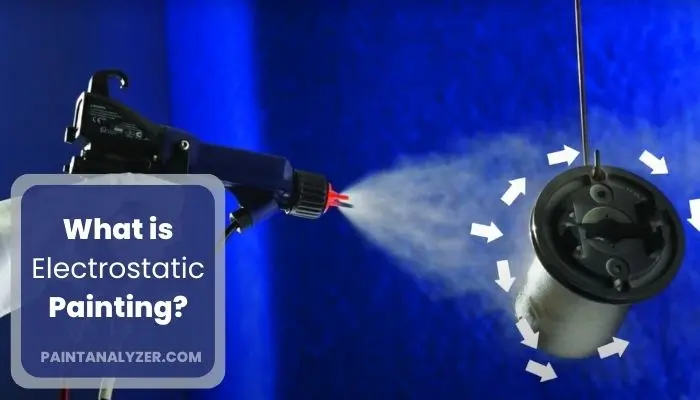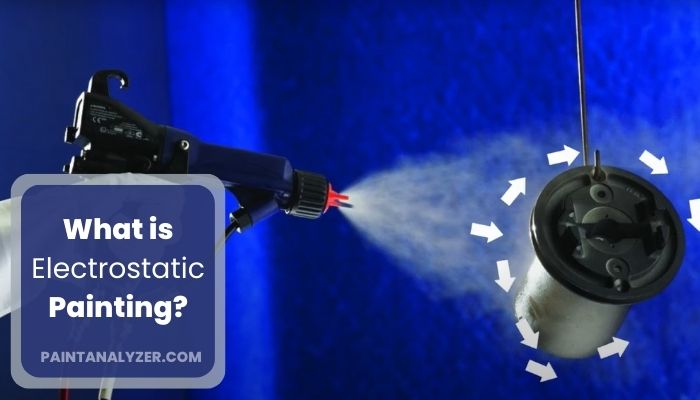Electrostatic painting is a process that uses electrically charged particles to adhere paint to metal surfaces. The paint is attracted to the metal surface by the electrostatic charge, which creates a corrosion-resistant bond.
This unique painting method has several benefits that make it ideal for a wide range of applications. Electrostatic painting is extremely efficient, as it requires less paint to achieve complete coverage of the surface. This means that electrostatic painting is more cost-effective and better for the environment.
In addition, electrostatic painting produces a more consistent and even finish than traditional painting methods. This makes it ideal for surfaces that require a high level of detail or a smooth, professional finish. Moreover, electrostatic painting is a safe and non-toxic painting method that does not produce harmful fumes.

What is The Purpose of Electrostatic Painting?
The purpose of electrostatic painting is to provide a protective coating for metal surfaces. This type of painting uses an electrical charge to attach the paint to the metal surface. The paint is then drawn into the metal surface, creating a smooth and even coat.
Electrostatic painting is often used on metal surfaces that are difficult to reach or that require a smooth and even finish. It is also often used for painting car parts, as it can provide a more even and durable finish.
The electrostatic charge helps the paint to adhere to the metal surface better than if it were just applied with a brush or roller.
Where Can I Use Electrostatic Paint?
Electrostatic paint is commonly used in a wide variety of industries and applications due to its inherent advantages over traditional painting methods. Its ability to evenly distribute paint over surfaces, as well as its resistance to dripping and sagging, make it an ideal choice for many different types of projects.
The process of this type of painting begins with a piece of equipment called an electrostatic spray gun. This gun applies a negative charge to the paint particles, which are then attracted to the surface that is being painted. The result is a smooth and even coat of paint that has excellent adhesion.
Some of the most common uses for electrostatic paint include painting automobiles, metal surfaces, appliances, and even some types of furniture. In each of these cases, the smooth, even coverage provided by electrostatic paint can give the final product a much more polished and professional look.
What are the Benefits of Electrostatic Painting?
Electrostatic painting is often used in industrial and commercial applications, as it provides a number of advantages over traditional painting methods. Some of the benefits of electrostatic painting include the following:
Achieving a high-quality finish
Traditional painting methods can often leave behind streaks or uneven areas. Electrostatic painting creates a more even coating, resulting in a professional-looking finish.
Increased paint adhesion
The electrical charge helps to increase the adhesion of the paint to the surface, resulting in a longer-lasting paint job.
Saving time
Electrostatic painting is a fast and efficient way to achieve a high-quality finish, meaning you can complete your project in a shorter time frame. This type of painting also eliminates the need for a primer, which can save both time and money.
Reducing waste
As electrostatic painting is a highly efficient process, it provides a more even coat of paint and can reduce the amount of paint waste. Electrostatic painting typically uses less paint than traditional painting methods.
What are the Disadvantages of Electrostatic Painting?
If you’re considering electrostatic painting as a way to paint your next project, there are a few things you should know about the potential disadvantages of this method. While electrostatic painting can provide a high-quality, professional-looking finish, it’s not without its drawbacks. Here are a few disadvantages of electrostatic painting to consider before you decide if it’s the proper method for your next painting project.
Limited Color Selection
When compared to other painting methods, electrostatic painting has a limited color selection. This is because only certain colors can be achieved through electrostatic spraying. If you’re looking for a specific color or finish, it’s important to check with your chosen Electrostatic Spraying Company to see if they offer the color you’re looking for.
Increased Risk of Fire
As electrostatic spraying involves using electrical current, there is an increased risk of fire when compared to other painting methods. It’s important to take proper safety precautions when working with any kind of electrical equipment, and be sure to follow all manufacturer instructions when using an electrostatic sprayer.
Health Risks
There are some health risks associated with using an electrostatic sprayer, due to exposure to chemicals and fumes. If you’re concerned about these risks, be sure to wear proper protective gear when using an electrostatic sprayer, and ventilate the area well while spraying (and after).
Potential Damage to Surfaces
Electrostatic spraying relies on electrical current, so there is a risk of damaging delicate surfaces such as electronics or jewelry if they come into contact with the electrical charge during spraying.
Electrostatic Painting or Conventional Spray Painting – Which One Is Better?
Spray painting and electrostatic painting are two popular methods for applying paint to metal surfaces. The process of electrostatic painting is different from standard spray painting because it uses magnetic attraction between the paint and the metal surface. Both have their advantages and disadvantages, so it’s important to choose the right method for your project.
Spray painting
Spray painting is the more conventional method and involves using a compressed air system to atomize the paint into a fine mist. This mist is then applied to the surface, where it dries and forms a protective coating. Conventional sprayers can make it difficult to achieve an even coating, as paint can end up going where the gun is pointed, resulting in overspray.
Electrostatic painting
Electrostatic painting uses an electric charge to attract the paint particles to the surface. This makes for a very even coat of paint that can be difficult to achieve with spray paint. However, electrostatic painting does require specialized equipment, which can be costly.
In summary, many think that electrostatic painting is better than conventional spraying. The main reason is electrostatic painting saves paint. It can use less paint because fewer passes are needed to cover the entire area. With electrostatic painting, only a few drips out during the process, and the amount of waste is less. Paint also sticks better and adheres to the surface. The electrostatic painting is more environmentally friendly than traditional spraying.
What Is The Cost Estimate For Electrostatic Painting?
When it comes to painting your home or office, there are many factors to consider – including cost. If you’re looking for a high-quality, long-lasting paint job, electrostatic painting may be the right choice for you. Here’s what you need to know about electrostatic painting costs:
On average, electrostatic painting costs between $1 and $5 per square foot. This price includes both the materials and labor necessary to complete the job. In most cases, electrostatic painting is more expensive than traditional methods like roller or brush painting. For a small project, the cost can range from $50 to $200. For a larger project, the cost can range from $500 to $2,000.
However, it offers a number of advantages that make it worth the extra cost. Electrostatic painting produces a much higher quality finish than other methods. The paint is evenly applied and adheres well to surfaces, resulting in a professional-looking finish that will last for years.
Additionally, electrostatic painting is less likely to produce drips or runs than other methods – making it ideal for areas like trim work where a clean look is essential. If you’re considering electrostatic painting for your next project, be sure to get multiple estimates from qualified contractors before making a decision. Once you’ve chosen a contractor, be sure to ask about their experience with this type of painting and whether they offer any warranties on their workmanship.
With proper preparation and careful execution, your electrostatic painted surfaces will provide years of beauty and protection!
Is Electrostatic Paint A Durable Alternative?
It is often said that electrostatic paint is more durable than other types of paint. But is this really true? Let’s take a closer look.
Electrostatic paint is made with electrically-charged particles that are attracted to metal surfaces. This makes for a very strong bond between the paint and the metal. And because the bond is so strong, electrostatic paint is more resistant to chipping and flaking than other types of paint.
Electrostatically-painted surfaces also tend to be smoother and more uniform in appearance. This is because the paint particles are evenly distributed over the surface. It also has a higher level of adhesion, meaning it will stick to surfaces better. This makes it ideal for surfaces that are exposed to high levels of wear and tear.
Overall, electrostatic paint is a more durable option than other regular types of paint. If you’re looking for paint that will stand up to the rigors of daily use and give you a smooth, professional finish, electrostatic paint can be a good choice.
How To Paint With An Electrostatic Spray Gun And How It Works?
Conclusion
In conclusion, electrostatic painting is essential to many industries. It is a type of electrostatic powder coating that uses electrically charged paint particles to paint. It is widely used in many industries due to its many advantages. This painting process is much quicker than other methods without sacrificing quality. Moreover, this method is environment-friendly.
Electrostatic painting technology has been widely used in many industries, such as the manufacture of automotive, household appliances, electrical appliances, footwear, hardware, hardware tools, hardware instruments, textiles, building materials, paper, printing & dyeing, valves, pumps, plastic, etc.
